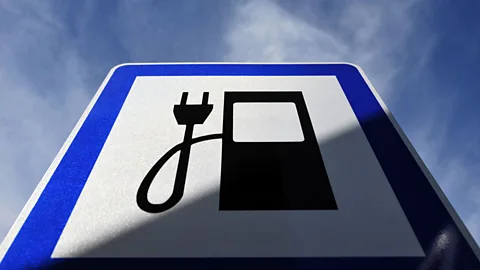Wireless recharging: Pulling the plug on electric cars

 Getty Images
Getty ImagesThe novel technology that aims to solve battery powered car’s biggest problem.
Ask the owner of an electric car which feature they would like to eliminate and chances are they will say the charging cord: no one likes having to remember to plug-in their vehicle every evening.
As a result, several companies including Delphi, Nissan, Qualcomm, and Rolls-Royce have either developed or tested wireless charging technology that requires drivers of electric vehicles to merely park above a device embedded in a garage floor or parking space that enables them to power up with little to no effort.
Other ideas – such as roads fitted with charging devices – have also been proposed, but, to date, most systems rely on a well-known technique called electromagnetic induction. It is the same technology used to charge electric toothbrushes. At its most basic, a varying electric current passes through a coil of wire in the transmitter which produces a similarly varying current in a receiver coil sitting just above. The transmitted electrical power then feeds into the battery and recharges it. In a toothbrush, the transmitter sits in the base, while the receiver sits in the brush.
But electromagnetic induction technology across an air gap – say from a recharging pad to a car - is not considered the perfect solution by everyone. Critics point out it could possibly emit stray radio waves or heat up nearby metal objects unless it is engineered just right - two issues that the wireless electric vehicle industry knows could sink the technology if the public perceive them to be dangerous. “Perceive” is the key word here, as the industry strongly affirms that their power transfer technology has been fully tested and shown to be completely safe. “We crossed that threshold two years ago,” says David Schatz, vice president of sales & business development at WiTricity, a top maker of automotive recharging equipment. “The codes and standards are being written now.”
Poles apart
But now, researchers at the University of British Columbia (UBC) in Vancouver working on how to recharge medical devices such as heart pacemakers, may have developed an alternative that avoids radio emissions altogether. They have produced a safe, high-efficiency method that employs what applied physicist and inventor Lorne Whitehead describes as “remote magnetic gears”.
The new non-contact power-transfer approach, Whitehead says, uses “magneto-dynamic coupling,” a simple magnetic field interaction between two pivoting permanent magnets that are separated by 10 to 15cm (4 to 6in) of air. The system uses a transmitter magnet below and a receiver magnet up in the car. When a small electric motor turns the lower magnet, the magnetic field causes the upper one to turn, “much as a compass follows a changing magnetic field,” he says. The top magnet then drives a small generator that charges the car battery.
“This magnetic field between them essentially acts as a mechanical coupling - an invisible magnetic pulley/belt system, but it requires no direct contact and is almost perfectly energy efficient,” Whitehead explains. In production the two magnets could be integrated, respectively, into the motor and the generator, making for a reliable and compact power-transfer system.
“Tests show the system is more than 90% efficient compared to a cable charge,” he says and the car does not even need to be perfectly aligned with the device. As a result, it could be built into low street curbs over which the car-borne magnet (which is installed under the bonnet) would hang, he says.
A demonstration system consisting of four rechargers has operated successfully on the UBC campus for about a year or so, where they wirelessly charge electric vehicles that have been retrofitted with receiver magnets. “Since we began testing the system, the feedback from drivers has been overwhelmingly positive - all they have to do is park the car and the charging begins automatically,” said David Woodson, managing director of UBC building operations, recently.
But not everyone is convinced. “It’s really nothing new,” says John M Miller, center director in the power electronics and electric machinery research group at Oak Ridge National Laboratory in Tennessee. “Too many moving parts; it all comes down to the number of energy conversions that are involved." Here, the energy goes from electrical to mechanical and back to mechanical and then to electrical, the electrical engineer explained. And each step entails a loss in energy efficiency that adds up.
WiTricity’s Schatz was similarly skeptical, pointing out that leading automakers have already settled on designs that will be introduced “around 2015 to 2017”. The biggest interest is to place them in so-called plug-less hybrids, he says. In addition, the industry expects forthcoming devices to “be approaching the size and shape of a sheet of paper and lightweight to boot,” something that is perhaps at odds with the UBC magnetic system. WiTricity’s power-transfer technology – sometimes known as wireless electricity - has no moving parts and exploits a high-efficiency coupling between transmitter and receiver—a one-step energy transfer.
However, the UBC team is undeterred. A patent is now in the works and Whitehead expects that the technology will be licensed to other manufacturers, most likely through a spin-off company. “At this point we see no technological barriers to bringing this system to market and know no reason why it will not become the preferred mechanism for wireless charging of [electric vehicles].”
If you would like to comment on this article or anything else you have seen on Future, head over to our Facebook page or message us on Twitter.
